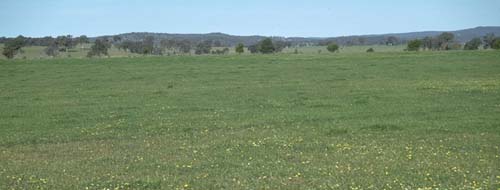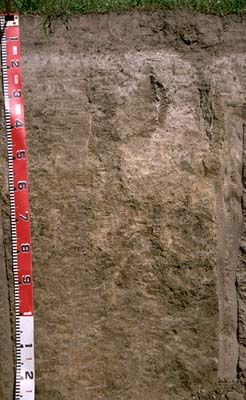NE13
| Group: Springhurst-Byawatha Hills Landcare Group | |
| Australian Soil Classification: Bleached-Sodic (and Vertic), Hypocalcic, Brown DERMOSOL (medium, non-gravelly, clay loamy / clayey, very deep+) | |
| Northcote Factual Key: Gn 3.06 | Great Soil Group: no suitable group |
| General Landscape Description: Old alluvial plain with prior stream activity. This site occurs on what was probably the near floodplain of a prior stream. Original vegetation included Grey Box (Eucalyptus microcarpa). | |
Site Description:
 NE13 landscape |
Soil Profile Morphology:
Surface Soil
| O | 0-1 cm | Very dark greyish brown (10YR3/2); fine sandy clay loam; very firm consistence dry. |  NE13 profile |
| A1 | 1-15 cm | Dark brown (10YR3/3); fine sandy clay loam; hardsetting surface condition; weak coarse blocky structure; very firm consistence dry; contains a few (5%) manganese nodules (<6mm size); rusty root channel mottling present; pH 5.4; abrupt and wavy change to: | |
| A2 | 15-20 cm | Brown (10YR5/3) conspicuously bleached (10YR7/1d); light sandy clay loam; massive; strong consistence dry; contains a few (10%) quartz gravels (2-4mm size); pH 5.8; sharp and wavy change to: | |
| Subsoil | |||
| B1 | 20-55 cm | Brown (10YR5/3); sandy clay loam; massive; very firm consistence moist; contains a common (20%) amount of quartz gravel (2-8mm size) ; pH 6.3; clear change to: | |
| B21 | 55-65 cm | Greyish brown (10YR5/2) with yellowish brown (10YR5/8) mottles; sandy clay loam; weakly structured; very firm consistence moist; contains a common (20%) amount of quartz gravel (2-4mm size); pH 8.2; clear change to: | |
| B22 | 65-85 cm | Brown (10YR5/3) with a yellowish brown (10YR5/6) mottles; light medium clay; weak to moderate coarse blocky structure; (smooth faced peds); strong consistence moist; contains a common (20%) amount of hard to semi-hard ferromanganiferous nodules (<6mm size), and a common (20%) amount of quartz gravel (2-4mm size); pH 8.6; clear change to: | |
| B23 | 85-100 cm | Yellowish brown (10YR5/4); medium clay; moderate blocky structure (smooth faced peds); small slickensides present; contains quartz gravel (2-6mm size) in patches; pH 8.7; gradual change to: | |
| B24 | 100 cm+ | Yellowish brown (10YR5/4) with slight yellowish brown (10YR5/8) mottles; medium clay; moderate coarse blocky structure (smooth faced peds); contains a few (5%) quartz gravel (4mm average size); pH 8.8. | |
Key Profile Features:
- Lack of strong texture contrast between surface (A) horizons and subsoil (B21) horizon
- Sodic subsoil horizons.
Soil Profile Characteristics:
Horizon | pH | Salinity Rating | ||
Surface (A1 horizon) | strongly acid | very low | non-sodic | none 1 |
Subsoil (B1 horizon) | slightly acid | very low | sodic | slight |
Deeper subsoil (at 1 m) | strongly alkaline | low | strongly sodic | complete |

Horizon | Horizon Depth (cm) | pH (water) | pH (CaCl2) | EC 1:5 | Exchangeable Cations | |||
Ca | Mg | K | Na | |||||
meq/100g | ||||||||
A1 | 1-15 | 5.3 | 4.5 | 0.05 | 4.5 | 1.9 | 0.6 | 0.1 |
A2 | 15-20 | 5.8 | 4.6 | <0.05 | 1.5 | 0.8 | 0.2 | 0.1 |
B1 | 20.-55 | 6.3 | 5 | <0.05 | 2.7 | 2.6 | 0.3 | 0.4 |
B21 | 55-65 | 8.2 | 6.8 | 0.09 | 4.3 | 5.1 | 0.2 | 1.7 |
B22 | 65-85 | 8.6 | 7.1 | 0.14 | 6.0 | 8.1 | 0.4 | 2.8 |
B23 | 85-100 | 8.4 | 7.4 | 0.18 | 6.3 | 9.4 | 0.5 | 3.7 |
B24 | 100+ | 8.8 | 7.5 | 0.23 | 6.6 | 11 | 0.6 | 5.0 |
Horizon | Horizon Depth (cm) | Exchangeable Aluminium mg/kg | Field Capacity pF 2.5 | Wilting Point pF 4.2 | Coarse Sand (0.2-2.0 mm) | Fine Sand (0.02-0.2 mm) | Silt (0.002-0.02 mm) | Clay (<0.002 mm) |
A1 | 1-15 | 64 | 28.5 | 10.4 | 16 | 27 | 26 | 26 |
A2 | 15-20 | 15 | 4 | |||||
B1 | 20-55 | 18.3 | 7.5 | 27 | 36 | 19 | 19 | |
B21 | 55-65 | 21.8 | 10.2 | 28 | 31 | 16 | 26 | |
B22 | 65-85 | |||||||
B23 | 85-100 | |||||||
B24 | 100+ |
Management Considerations:
Whole Profile
- Plant available water capacity (PAWC) is considered to be low (estimated at 60 mm) for this site. This is based on available laboratory data and assumes an effective rooting depth of 55cm. Rooting depth is likely to be limited by the strongly sodic dense and poorly structured deeper subsoil.
Surface (A) Horizon
- Organic matter is important for maintaining soil aggregation on hardsetting surface soils such as these with high fine sand (27%) and silt (26%) contents. At low organic matter levels, structural degradation (eg. exacerbated hardsetting, surface sealing and compaction) is more likely to occur. Maintaining adequate organic matter levels is important to assist in reducing structural degradation and hardsetting. Practices such as minimum tillage, stubble retention and pasture rotation should be used if cropping occurs.
- The surface soil disperses moderately after remoulding. This indicates that over-stocking or excessive cultivation of these soils when moderately moist to wet may result in surface sealing and exacerbate the hardsetting condition. Raindrop action can have a similar effect to remoulding, so maintaining a protective cover of plants or stubble is important.
- The surface soil is strongly acid which indicates that aluminium and manganese toxicity may occur. A bulk paddock sample taken from around this site, however, had a relative low level of exchangeable aluminium (28 mg/kg) which is not likely to restrict plant growth of many plants. Raising the pH level of the surface soil will help reduce any toxic levels of aluminium. Other factors need to be considered, however, before lime is recommended (eg. pasture species grown, method of application, local trial responses, soil surface structure, likely cost/benefits).
- Deficiencies in molybdenum, phosphorus and potassium may occur in strongly acid soils. If lime is required, an application may assist in alleviating molybdenum deficiency and will increase phosphorus availability as well as raising soil pH. The State Chemistry Laboratory (SCL) states that molybdenum is commonly required on soils in this area at about 50-60 grams/hectare every 5-6 years. Plant tissue analysis will generally give a more accurate assessment of trace element (eg. molybdenum) requirements compared to soil samples. A sample of the most dominant clover should be taken in spring for this assessment.
- Available phosphorus (Olsen method) was measured on a bulked paddock sample. It was at the lower end of the target range for a lightly stocked paddock. SCL recommends that this paddock be topdressed in autumn with 6-7 kg/ha of actual phosphorus.
- Sulphur levels measured on the bulked paddock sample are low-moderate for this site. At these levels SCL recommends that a fertiliser with a reasonable sulphur content (ie. at least 6% sulphur) be used. To assess responses to sulphur on a paddock, apply a test strip of gypsum (calcium sulphate) at 200-300 kg/hectare in early spring. Gypsum may also have some benefit in ameliorating soil sodicity at this site.
- The potassium level measured from the bulked paddock sample is adequate. SCL suggests that potassium is not normally recommended in this district unless stocking rates are high.
- Below 15 cm depth, the pH (water) increases to above 5.5. At such a pH level, aluminium toxicity is not likely to be a problem.
Subsoil (B) Horizons
- The dense and coarsely structured subsoil horizons are sodic and disperse strongly in water. This will result in restricted root and water movement into the subsoil. Waterlogging is likely to occur after heavy rains. The presence of a conspicuously bleached A2 horizon and rusty root channel mottling in the surface horizon indicates that drainage into the subsoil is being restricted.
- The deeper subsoil exhibits vertic properties (ie. presence of slickensides) which indicates that significant shrinking and swelling occurs upon wetting and drying. This can have implications for engineering purposes (eg. building foundations, fence posts). The presence of vertic properties would explain the tendency of the land to develop ‘crabholey’ microtopography.
Comments from Landholder:
- Not cropped for 20 years, but prior to this it was cropped a dozen times. Stopped cropping because it was too wet.
- Originally ‘crabholey’ country.
- Typical soil on flat country.


